先引用-The Industrial History of Hong Kong Group-的資料,在沙螺灣的篇章也提到過...此組織專業,當中的資料都是十分古舊難尋的資料,且範圍分類極廣,資料多的同時又不失重點,資料極其詳盡,也是一般人未必能找到的史料。他們亦會進行實地考察考究,實在令人敬佩...這些專業的研究家,對比之下只憑自己一人之力,所尋得的所謂「資料」簡直是笑話一則,相判雲泥...自覺實在慚愧不如,故以後我也只能在礦物資訊及實地考察方面進行考究望能提供更多資料...
另外我已就這些資料進行第一次初探,只是順路粗略一探,有興趣者可到另一新篇章《大棠錫/鎢礦場--略探》查看
以下為經翻譯的文章,由於加上原文(英文)後,中英夾雜的文章顯得十分雜亂,閱讀起來不方便,故我把原文放了在尾段,或可直接到網站觀看,開首已有其網站超連結(另外也是google翻譯很多錯誤,文句調轉、多義詞、專有名詞等,加入了少量說明)
希望大家細閱(比起組織搜尋鑽研資料的付出努力,我的翻譯之功實在不值一提)
------------------------------------------------------------------------------------------------------------------------------------
ymon Mellor(此文章的發表者):
在上一篇關於香港錫礦開探的文章中,在元朗附近發現了戰前錫礦的存在,但該礦的實際位置是一個謎。經過進一步研究,已確定有關該礦及其位置的新細節。
來自1932年中國商會的Lui Yum-suen(雷蔭蓀)董事肖像(來源:1932年華商總會年鑑),由June Fung提供。)
在1906年推行“勘探和採礦條例”後,各方可以尋求勘探許可證,採礦許可證或採礦租約。這為最近的新界開闢了未來礦主收購的願望。各個採礦申請都已註冊,並且已分配採礦批號以確保沒有重疊的擁有權。
我還未能夠追查清單的完整副本,但在1941年太平洋戰爭(1941-1945)開始之前至少發出了13個許可證。許可證編號13適用於大棠的山丘地區,用於開採錫和黑鎢礦。採礦許可證由總督於1940年11月14日,以天盛礦業公司的名義向雷蔭蓀先生及何侶俠先生發出,為期21年。
原本的申請和批准的細節尚未確定。 但是,公共記錄辦公室有三個與採礦許可證相關的文件。 採礦申請於1940年9月26日由總督會同行政局根據標準租賃條件批准,並增加了一項防止水污染和控制礦山衛生狀況(環境方面)的條款。 1941年1月3日,雷先生和何先生要求將採礦區覆蓋的面積擴大80英畝。經修訂的採礦租約於1941年3月1日由總督會同行政會議批准。

- 農民抱怨
1951年11月,當地農民抱怨說,礦山的沉渣堵塞了水道,破壞了肥沃的山谷中的農業活動。農業,漁業,樹林(漁農處前身?)主任T G Strangeways先生訪問了該地區,並找到了問題。該礦由一位“著名的香港商人” Lau Yam Suen(雷蔭蓀)先生管理,並通過淘汰河中的已開採礦石來提取低品位的黑鎢礦石。這種方法導致沉渣沿河流流入肥沃的山谷,至下游長達2公里。農民每年生產兩種優質大米和一種蔬菜,如蕃茄,茄子和菜(choi)。一些農民也在種植涼薯和白黃瓜。灌溉系統的淤積破壞了他們的農作物。
Strangeways先生並不開心,因為在他的備忘錄中,於1951年11月13日他向區專員表明,“我知道你完全了解情況的嚴重性,但我覺得我必須繼續提起這件事。在我看來,在一個小且集中的高度發展殖民地,像我們在這裡有的一樣,採礦作業總是被允許於山坡上以影響着農耕地區,這是一個悲劇。
- 礦場訪問
1951年11月14日,礦業總監W M Keays先生於距離元朗最近的公路沿著稻田行走了3.5英里,探訪了礦場。他指出兩項採礦作業正在進行中。黑鎢礦在三個露天礦坑中開採,提取的材料通過閘門箱洗滌以分離重礦石。礦山運營商建立了一條管道,將水從河流上方100米處運到三個水閘箱中,將礦石與原石分開。 Keays先生對這一安排印象深刻,“這件工程非常巧妙”。該過程的缺陷是用於收集經沖洗過的碎屑的五個水壩被淤塞,導致淤泥向下流入田地。
一個錫礦位於“堅硬的圍岩”中相鄰山丘的頂部附近。該礦最初採用露天開採,但後來有一個礦坑入口(adit)開始跟隨礦脈開採。管理人興建了一個火藥庫,用於存放挖掘礦坑通道所需的炸藥。在訪問期間,礦工領頭告知在“一些月份”沒有開採錫礦。
Keays先生記錄了礦石產量“在過去兩個月內大幅下降”,他將此歸因於將工作分包給“北方人”(大概是指礦場北面的工作群)。天盛礦業有限公司,在彌敦道30號玫瑰酒店的管理,有14天時間來糾正所發現的問題。
關於Strangeways先生對採礦業的評論,勞工處處長於1951年11月26日作出回應,指出“我擔心我們必須正視這樣一個事實:雖然鎢,錫,鉛和其他礦石的價格居高不下,但在這個殖民地充滿了生活在邊緣邊持生計的人,若要阻止這些礦石的採礦是完全不現實的(即這些礦石很值錢所以阻止不了總有人會開採)。我們最希望做的是通過嚴格的執法行動在某些特定地區盡量防止它,並在其他地區通過堅持採用有執照的礦工採用合適的採礦方法來控制影響“。
- 採礦地塊13(Mining Lot No.13)—擁有權的收回
1953年5月,在沒有解決已確定的問題的情怳下該礦的生產重新開始。
該列單增加包括:
-礦工的住房要達到標準;
-廚房和廁所應按規定建造,同時的;
-清理沉澱的水壩。
此外,礦務總監(政府機關的警司)對礦場的採礦方法表示不滿意,正如1953年5月22日給天盛礦業公司的信中所述“有關你打算在你的礦山上安裝什麼機器的詳細信息,你當下的開採方法不僅沒有生產力,而且會對山坡造成大量不必要的侵蝕,這是不能再容忍的。 請注意,採礦只能按照現行的標准進行“。 這封信最後提到,除非採取改善行動,否則將徵兆礦區的擁有權將會被回收。(擁有權回收(Re-entry)是取消和關閉採礦作業並取消採礦許可證的正式程序)
該公司於1953年6月24日作出回應,表明他們已滿足所有要求,並認為該住宿適合在該礦工作的20名男子。 他們尋求許可繼續採礦並出售50斤(30公斤)的礦石。 他們還提到他們找到了他們希望開採的新黑鎢礦礦脈。 礦業總監在1955年3月11日的內部備忘錄中指出,在沒有任何改進措施的同時,最後的生產數據是1953年2月20日的46斤(27.8千克)錫和111斤(67千克)黑鎢礦。在1953年6月之後,礦主沒有進一步溝通,直到1955年發現雷先生和何先生皆已經去世時,才明確其原因。 雷先生及何先生均於77歲隣近時於約1953年12月29日去世。 故該礦的文書工作存在問題,因為兩位業主都已經死亡,儘管礦區已經批准從最初的26.29英畝擴大到109.79英畝,政府的租金已按較小的價值收取。根據礦業總監的說法,採礦已於1953年2月停止,這意味著根據採礦許可證第9(1)條,“如果香港總督認為(其有最終決定權),承租人若沒有在12個月其間有任何實際的工作,“政府可以將礦山的”擁有權回收“(Re-entry)並取消採礦許可證。 與業主的親屬進行討論後並未明確表達及後對該礦的打算。 因此,在1955年10月3日,香港唯一的錫礦"擁有權回收"的通知被公佈,採礦許可證被取消。
- 現時礦山
現時的礦場隱藏在山坡的叢林下。從山路上您可以看到礦場工作的痕跡,包括挖掘過程中的水泥人行天橋。然而,大多數路人都會錯過這些線索。只有當你離開主路並探索叢林時,你便會發現沿著山坡上沿着礦脈的挖掘工作。
根據礦業總監的說法,若使用炸藥挖掘出一個礦坑的這種開採方式,礦工們最有可能從花崗岩內的石英脈中挖掘出錫礦石-錫石(cassiterite)。但是尚未找到礦坑(adit)入口的確切位置。
大棠的錫礦於1940年至1953年投入生產,由於兩位業主的去世而關閉。該礦在兩個方面是獨一無二的。它是香港唯一的錫礦,也是香港唯一一家政府採取行動“擁有權回收”(Re-entry)取消採礦許可證的礦山。不幸的是,這個礦場的故事已經在歲月中消失、挖掘工作亦在叢林中煙沒。
------------------------------------------------------------------------------------------------------------------------------------
以下為-The Industrial History of Hong Kong Group-《Tin Mine at Tai Tong (Mining Licence No 13)》篇章原文(英文)
Tymon Mellor: In the previous article on tin mining in Hong Kong, the existence of a pre-war tin mine was identified near Yuen Long but the actual location of the mine was a mystery. Following further research, new details on the mine and its location have been identified.
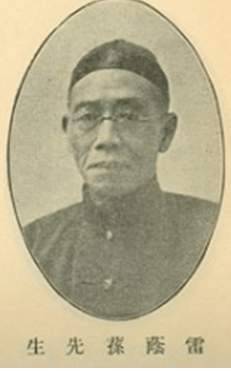
Lui Yum-suen from 1932 Chinese Chamber of Commerce board portraits (Source: 1932華商總會年鑑), Courtesy of June Fung.)
This opened up the recently acquired New Territories to the aspirations of the prospective mine owners. Each mining request was registered and a mining lot number was allocated to ensure that there were no overlapping claims.
I have not yet been able to track down a full copy of the list, but there were at least 13 licences issued before the start of the Pacific War in 1941.
Licence number 13 was for an area of foothills in the Tai Tong district for the mining of tin and wolframite.
The mining licence was issued by the Governor on the 14th November, 1940 to Mr Lui Yam Suen and Mr Ho Lui Hup in the name of the Tin Shing Mining Company for a period of 21 years.
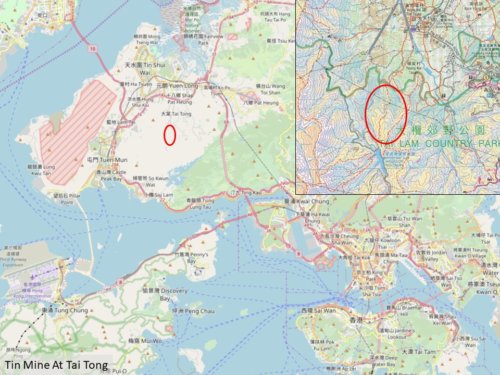
Details of the original application and approval have not been identified. However, the Public Records Office has three files associated with the mining licence. The mining application was approved by the Governor in Council on the 26th September, 1940 based on the standard lease conditions with the addition of a clause to prevent water pollution and to control the health conditions at the mine. An extension of the area covered by the mining lot for an additional 80 acres was requested by Messrs Suen and Hup on the 3rd January, 1941. The revised mining lease was approved by the Governor in Council on the 1st March, 1941.

Farmers Complaining
In November, 1951 there was a complaint from the local farmers that sediment from the mine was blocking drainage channels and disrupting farming activities in what was a fertile valley. The Director of Agriculture, Fisheries and Forests, Mr T G Strangeways paid a visit to the area to see the problems for himself. The mine was managed by a “prominent Hong Kong businessman”, Mr Iau Yam Suen, and was extracting low grade Wolframite ore by panning the excavated ore in the river. This approach resulting in sediment being carried along the river and into the fertile valley for up to two miles downstream. The farmers were producing two crops of good quality rice, and one crop of vegetables such as tomatoes, eggplant and choi a year. Some farmers were also growing yam beans and white cucumber. Siltation of the irrigation systems was disrupting their crops.
Mr Strangeways was not a happy man as his memo 13th November 1951 to the District Commissioner made clear, “I know you are perfectly aware of the seriousness of the situation, but feel that I must keep on rubbing it in. To my mind, in a small intensively cultivated Colony, such as we have here, it is a tragedy that mining has ever been allowed on hillsides feeding cultivation areas below”.
Mine Visit
Mobilised into action, the Superintendent of Mines, Mr W M Keays paid a visit to the mine on the 14th November, 1951, walking the 3½ miles along paddy field tracks from the nearest road from Yuen Long. He noted two mining operations were in progress. Wolframite was being mined in three open pits, with the extracted material being washed through sluice boxes to isolate the heavy ore. The mine operator had set up a pipe line to bring water from 100m higher up the river to power three sluice boxes separating the ore from the native material. Mr Keays was impressed with the arrangement, “This piece of engineering is very ingenious”. The flaw in the process was that the five dams used to collect the washed debris were silted up, resulting in silt passing down-stream into the fields.
A tin mine was located near the crest of the adjacent hill in “hard country rock”. The mine started as open-cast, but a subsequent adit had been started to follow the mineral vein. The owner had built a magazine to hold the explosives necessary to excavate the adit. During the visit, the mine foreman advised that no tin mining had been undertaken for “some months”.
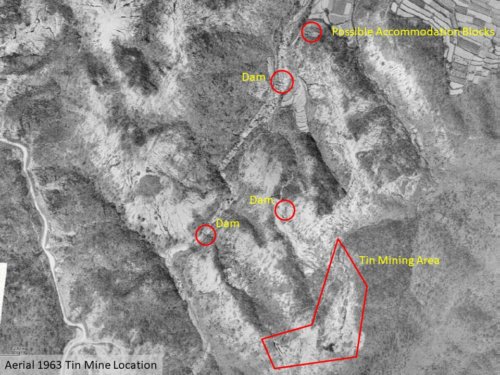
Mr Keays recorded that the output of ore had “dropped considerably in the last two months”, and he attributed this to the sub-contracting of the work to “Northerners”. Tin Shing Mining Co, care of the Rose Hotel, 30 Nathan Road, was given 14 days to rectify the problems identified.
With regard to Mr Strangeways’ comments on mining, the Commissioner of Labour replied on the 26th November, 1951 noting that “I fear that we simply must face up to the fact that while the price of wolfram, tin, lead and other ores remain high and while this Colony is filled with people who are living on the verge of subsistence, it is entirely unrealistic to think that we can prevent the mining of these ores. The most we can hope to do is to prevent it in certain specified areas by rigorous police action and in other areas to control it by insisting on decent mining methods being employed by licenced miners”.
Mining Lot 13 Re-Entry
In May 1953, production at the mine had recommenced without addressing the identified concerns. The list had also increased to include:
- miners’ housing accommodation to be brought up to standard;
- cook house and latrines are to be made according to regulations; along with
- clearing of the settling dams.
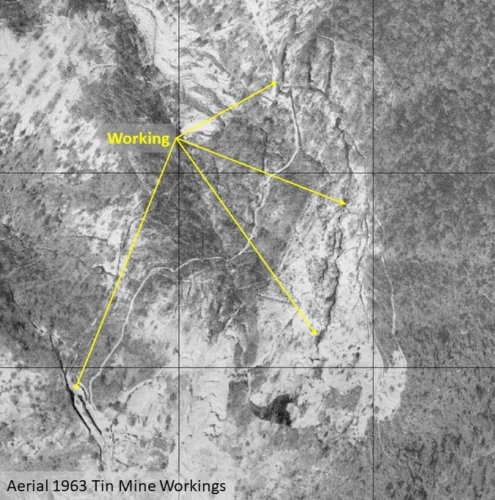
The company responded on the 24th June, 1953 indicating they had met all the requirements, and considered that the accommodation to be suitable for the 20 men working at the mine. They sought permission to continue mining and to sell the 50 catties (30kg) of ore in the mine store. They had also advised that they had located a new vein of wolframite ore which they wished to mine. The Superintendent of Mines noted in an internal memo of the 11th March, 1955 that the last production figures were dated 20th February, 1953 for 46 catties (27.8kg) of tin and 111 catties (67kg) of wolframite ore while none of the improvement measures had been undertaken. There were no further communications with the mine owners after June, 1953, and the reason for this would not become clear until 1955 when it was discovered that both Mr Suen and Mr Hup had died. Mr Suen outlived Mr Hup and died interstate on the 29th December, 1953 aged 77.
The paperwork for the mine was problematic as both owners were dead and despite the approved enlargement of the mining areas from the original 26.29 acres to 109.79 acres, the Government rent had been collected on the smaller value.
According to the Superintendent of Mines, mining had ceased in February, 1953, meaning that under the mining licence, clause 9(1), “if in the opinion of the Governor of Hong Kong (whose decision shall be final) the lessees have not been carrying on any bona fide work under this demise for a period of 12 month” the Government could “re-enter” the mine and cancel the mining licence. Discussion with the relatives of the owners provided no clear intent for the mine. Thus, on the 3 October, 1955 the notice to re-enter Hong Kong’s only tin mine was posted and the mining licence was cancelled.

The Mine Today
The mine today now lies hidden beneath the hillside vegetation. From the footpath you can see indications of the workings, including a concrete footbridge over the excavations. However, most passersby will miss the signs. It is only when you leave the path and explore the woods that you will find the excavations following the mineral vein up the hillside.
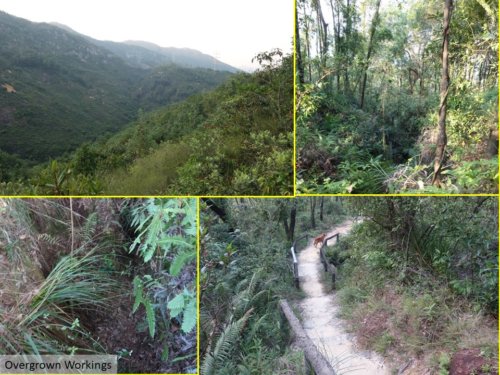
Based on the statements from the Superintendent of Mines that an adit was being excavated using explosives, the miners were likely to be excavating the tin ore cassiterite from a quartz veins within the granite bedrock. However, the exact location of the tunnel portal has not been located.
The tin mine in Tai Tong was in production from 1940 to 1953, and appears to have closed due to the death of the two owners. The mine was unique in two ways. It was the only tin mine in Hong Kong, and it was the only mine in Hong Kong where the Government took the action to “re-enter” and cancel the mining licence. It is unfortunate that this mine story has been lost to time and the workings lost to the vegetation.






沒有留言:
發佈留言